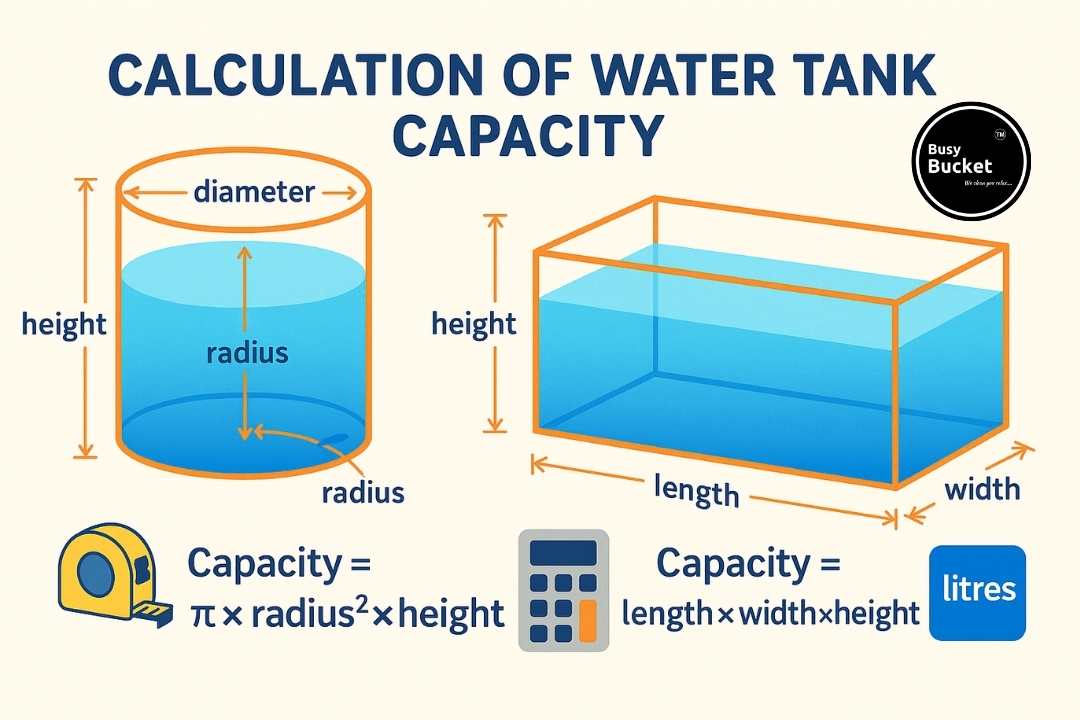Whether you’re planning to install a new water tank or maintain the one you already have, understanding the calculation method is very useful. In this blog, we’ll break down simple methods to calculate water tank capacity in litres for different shapes like rectangular, cylindrical, and overhead tanks, using easy-to-follow formulas.
Why Is Calculating Tank Capacity Important?
Understanding how to calculate water tank capacity in litres is more than just a mathematical exercise, it’s essential for efficient water management. Whether it’s for a home, apartment, or commercial setup, knowing the exact storage capacity of your tank can save you from several hassles. Here’s why it matters:
- Avoids Overflow & Wastage – Prevents excess water loss by matching supply with storage.
- Helps in Water Planning – Ensures enough water for daily household or business needs.
- Right Tank Selection – Guides you in buying the correct tank size for your property.
- Supports Cleaning Schedules – Helps plan professional cleaning by estimating how much water is stored.
- Prevents Shortages – Makes sure you don’t run out of water during high-demand periods.
Now that you know its importance, let’s move ahead and learn formulas to calculate tank capacity easily.
Formula to Calculate Water Tank Capacity in Litres
Calculating your water tank’s capacity in litres is simple once you know the tank’s shape and dimensions. The basic formula is:
Capacity (in litres) = Volume (in cubic meters) × 1000
The volume depends on the tank’s shape.
1. Rectangular or Square Tank
Volume = Length × Breadth × Height
Capacity (litres) = Length × Breadth × Height × 1000
Example: A tank 2m × 1m × 1m = 2 × 1 × 1 × 1000 = 2000 litres
2. Cylindrical Tank
Volume = π × Radius² × Height
Capacity (litres) = 3.1416 × Radius² × Height × 1000
Example: Diameter = 1.4m (Radius = 0.7m), Height = 1m → 3.1416 × 0.7² × 1 × 1000 ≈ 1539 litres
3. Conversion Tips
- 1 cubic meter = 1000 litres
- Always measure inner dimensions for accurate results
Each water tank and cleaning is different. You need to understand the type of water tank you have to get an accurate measurement. Now, we’ll see why regular water tank cleaning is essential for safe and healthy water.
Quick Conversion Tips
When calculating your water tank capacity in litres, it’s important to convert measurements correctly to ensure accuracy. Here are some simple tips:
- Cubic Metres to Litres – 1 cubic metre = 1000 litres. Multiply the tank volume in cubic metres by 1000 to get litres.
- Cubic Feet to Litres – 1 cubic foot = 28.316 litres. Multiply the volume in cubic feet by 28.316 to convert to litres.
- Measure Inside Dimensions – Always use the inner length, breadth, height, or radius of the tank for precise calculations.
- Round Off Sensibly – Minor rounding is acceptable, but don’t underestimate capacity, especially for cleaning or water planning purposes.
Now that you know conversion tips, let’s discuss why regular water tank cleaning is essential.
Importance of Cleaning Your Water Tank Regularly
After learning how to calculate water tank capacity in litres and conversion tips, the next crucial step is ensuring the stored water remains clean and safe. Over time, water tanks accumulate dust, algae, sediments, and harmful bacteria, which can contaminate the water you and your family use daily. Regular cleaning is essential to maintain hygiene, prevent health issues, and ensure your tank functions efficiently.
Here’s why regular water tank cleaning matters:
- Prevents Contamination – Removes dirt, algae, and bacteria that may cause waterborne diseases.
- Improves Water Quality – Ensures clear, odor-free, and safe water for drinking, cooking, and cleaning.
- Extends Tank Life – Prevents corrosion and damage caused by sediments or microbial buildup.
- Supports Efficient Water Usage – Clean tanks prevent clogging and maintain smooth water flow.
- Peace of Mind – Knowing your family has access to safe, healthy water reduces daily stress.
Ensure your water tank stays clean and hygienic. Book Busy Bucket Water Tank Cleaning Services today for professional, safe, and thorough cleaning.
Why Choose Busy Bucket Water Tank Cleaning Services?
A clean water tank is essential for maintaining safe, healthy water in your home or office. While many attempt DIY cleaning, it often fails to remove stubborn sediments, algae, and harmful bacteria completely. That’s where Busy Bucket Water Tank Cleaning Services come in.
We specialize in professional, reliable, and safe cleaning solutions for all types of water tanks, ensuring your water remains pure and your family stays healthy.
Here’s why Busy Bucket is the preferred choice:
- Expert Technicians – Trained professionals handle cleaning efficiently, ensuring no corner or residue is left behind.
- Advanced Equipment – Use of industrial-grade tools and methods guarantees deep cleaning that DIY cannot match.
- Eco-Friendly & Safe Products – Non-toxic cleaning solutions protect your family, pets, and the environment.
- Customized Cleaning Plans – Tailored services for underground, overhead, and commercial water tanks.
- Affordable & Transparent Pricing – No hidden costs; clear, budget-friendly packages with guaranteed satisfaction.
- Hygiene & Health Focus – Comprehensive cleaning removes bacteria, algae, and sediments for safe, potable water.
If you’ve just learned to calculate your tank’s capacity, the next step is ensuring it stays clean and germ-free. Book Busy Bucket Water Tank Cleaning Services today and give your family the gift of safe, healthy water.
Frequently Asked Questions
How do I calculate water tank capacity in litres?
Measure tank dimensions, determine its shape, calculate volume, and multiply by 1000 to convert cubic meters into litres.
How do I calculate capacity for a cylindrical tank?
Use π × radius² × height × 1000 to convert the tank’s volume into litres accurately.
Should I measure the inner or outer dimensions of the tank?
Always measure the inner dimensions for accurate calculation of the water storage capacity.
Why is knowing tank capacity important?
It helps manage water usage, prevents overflow, schedules cleaning, and ensures enough water for daily needs.


